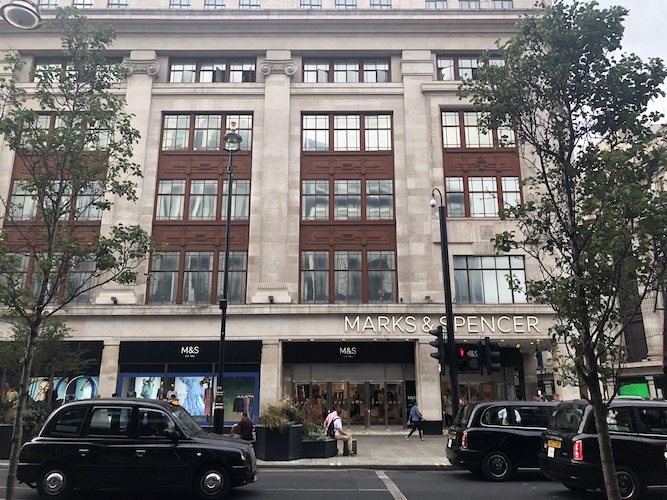The trouble began in November. Westminster City Council, at that time Conservative-controlled, gave the go-ahead to Marks & Spencer to demolish their flagship premises at 458 Oxford Street, which have stood next door to the mighty Selfridges for nearly 100 years, and have something completely new built in its place: a 10-storey mixed-use structure with retail, office and restaurant space and an arcade.
Fury. Protest. Dismay. Not from Historic England, which thought the Orchard House building – one of three that make up the Marks & Spencer site and occupies the corner of Oxford Street and Orchard Street – unworthy of protection, and not from the Greater London Authority, which chose not to intervene, but from preservationist groups The 20th Century Society and SAVE Britain’s Heritage, from Create Streets founder Nicholas Boys Smith and others, who have lately been joined by writer Bill Bryson.
The proposed replacement, designed by architects Pilbrow & Partners, has been damned as too big and as lacking both personality and stylistic sympathy with its famous next door neighbour. But this dispute is about more than conserving heritage. It is also about commerce in the context of London struggling to recover its economic buoyancy, and the production of carbon in the midst of the climate crisis and the pursuit of net zero.
Marks & Spencer, like other famous high street stores, believes it needs to rethink its Oxford Street operation in the light of changing consumer habits and the broader and still-unfolding post-Covid reconfiguration of the West End. The company and Pilbrow concluded that the internal structures of the current buildings, especially their pillars, are not consistent with providing the quality of space required for modern times. Meanwhile, the environmental dimension of the debate is generating particular heat and will perhaps produce significant light.
The then Conservative-majority planning committee was persuaded that any sustainability drawbacks in the short term will be more than compensated for in future, thanks largely to greater energy efficiency. But in June the scheme’s prospects were thrown into doubt when Michael Gove, in what turned out to be one of his final decisions as a government minister before he was sacked by Boris Johnson, called in the plans, partly due to concerns about their environmental impact.
As a result, the outcome of the inquiry is being seen as something of a test case for the strength of “retro first” arguments made by architects, engineers and the Architects’ Journal in recent years, which have prompted the government to look afresh at concerns about “embodied carbon”.
But Marks & Spencer, supported by the New West End Company business improvement district, were not amused by Gove’s intervention, accusing him of blocking “the only retail-led regeneration in the whole of Oxford Street” and potentially weakening “the appeal of the West End as an international centre”.
Westminster Council, now Labour-run after its famous first ever election win in May, is taking a judicious line. Geoff Barraclough, who in November was the sole member of the planning committee to oppose the Marks & Spencer scheme, is now the council’s cabinet member for planning and economic development. In a statement he said:
“This new council administration is serious about reducing the environmental impact of new development by emphasising the benefits of retrofitting over demolition. The M&S proposal has major implications in sustainability terms, so we welcome the inquiry called for by the Secretary of State as a means of allowing all the issues raised by this case to be rigorously tested in the public arena.”
Early on Monday evening I walked the full length of Oxford Street from east to west, passing en route another branch of M&S (its Pantheon at 173) and a taped-off Poland Street where earlier in the day a man had been stabbed to death. By the time I reached Marble Arch, having paused to contemplate the art deco frontage of the Marks & Spencer building, I think I had a fuller appreciation of the plight of the nation’s most famous retail avenue and the scale of the task of addressing it.
Depictions of Oxford Street as declining from grandeur into grot have been around for many years – when Elvis Costello described it as an “occidental bazar” in 1994 he seemed not to be paying it a compliment – but the proliferation of candy shops and the rank of blaring pedicabs plying for trade directly outside Selfridges created a sense of descent into an unregulated funfair, where nefariousness takes liberties and the authorities have limited control.
The fate of the Marks & Spencer building and the claims made for its potential successor now form a fraught strand of the larger Oxford Street story and the debate about how best to foster a flourishing future for it amid competing fears about economic contraction, social degeneration and climate catastrophe.
On London strives to provides the kind of journalism the capital city needs. Become a supporter for just £5 a month. You will even get things for your money. Details here.
